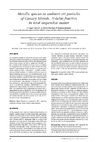Identificador persistente para citar o vincular este elemento:
https://accedacris.ulpgc.es/handle/10553/72223
| Campo DC | Valor | idioma |
|---|---|---|
| dc.contributor.author | Lopez Cancio, J. | en_US |
| dc.contributor.author | Deniz Sanchez, A. | en_US |
| dc.contributor.author | Santana Aleman,Pedro Juan | en_US |
| dc.date.accessioned | 2020-05-08T16:56:06Z | - |
| dc.date.available | 2020-05-08T16:56:06Z | - |
| dc.date.issued | 2013 | en_US |
| dc.identifier.issn | 0001-9704 | en_US |
| dc.identifier.other | WoS | - |
| dc.identifier.uri | https://accedacris.ulpgc.es/handle/10553/72223 | - |
| dc.description.abstract | At the present work total and water-soluble fractions of metallic species present in total suspended particulates (TSP) in an urban area of Gran Canaria (Canary Islands) were quantified. Experimental measurements were made from October 2004 to September 2005 on a total of 53 samples (4 or 5 per month). Particulate matter (TSP) was collected in fiber filters and high volume samplers. Average concentration was 68.5 +/- 35.5 mu g/m(3). TSP was determined gravimetrically. Water soluble fraction was extracted by sonication. Concentrations of metallic elements were analized by atomic emission spectrophotometry using an ICP-OES. According to their concentration levels, two categories of elements were found: "abundant" and "scarce" elements. In water soluble, "abundant" fraction consisted mainly of Na, Ca, K and Zn; among "scarce" Cu and Ti predomine. Availability of all soluble elements was stablished. High coefficients for all of them (specially for Mn with 99,9%) were found. In order to identify sources of metallic species factor analysis was used. The result show that Al, Ca, Fe, Mg, Na and K come from natural sources; Ni, Co, V, Mo, Pt, Zn, Cu, Sb and Cr from anthropogenic. | en_US |
| dc.description.abstract | En el presente trabajo se cuantifican las fracciones metálicas total y soluble de la materia en suspensión total (MST), en una zona urbana de Gran Canaria. Las medidas se realizaron entre octubre de 2004 y septiembre de 2005 sobre un total de 53 muestras (4 o 5 por mes). La materia en suspensión total se recogió en filtros de fibra de vidrio usando muestreadores de alto volumen. La concentración media resultó ser 68,5 ± 35,5 ~g/m3 . La MST se determinó gravimétricamente. La materia soluble en agua se extrajo mediante sonicación. Las concentraciones de los elementos metálicos se determinaron por espectrometría de emisión atómica, usando un ICP-OES. Se encontraron dos categorías de elementos de acuerdo con sus niveles de concentración: "abundantes" y "escasos". En la fracción soluble los "abundantes" fueron principalmente Na, Ca, K y Zn; entre los "escasos" predominan Cu y Ti. Se estableció la disponibilidad de todos los elementos solubles, encontrándose altos coeficientes para todos ellos y especialmente para el Mn(99,9%). A fin de identificar las fuentes para dichos elementos se usó el análisis factorial. Los resultados muestran que Al, Ca, Fe, Mg y K provienen de fuentes naturales, en tanto que Ni, Co, V, Mo, Pt, Zn, Cu, Sb y Cr son antropogénicos. | en_US |
| dc.language | eng | en_US |
| dc.relation.ispartof | Afinidad | en_US |
| dc.source | Afinidad [ISSN 0001-9704],v. 70 (561), p. 33-40 | en_US |
| dc.subject | 2391 Química ambiental | en_US |
| dc.subject.other | Airborne Particulate Matter | en_US |
| dc.subject.other | Trace-Metals | en_US |
| dc.subject.other | Source Identification | en_US |
| dc.subject.other | Pm2.5 Aerosols | en_US |
| dc.subject.other | Urban Area | en_US |
| dc.subject.other | Pm10 | en_US |
| dc.subject.other | Apportionment | en_US |
| dc.subject.other | Pollutants | en_US |
| dc.subject.other | Environment | en_US |
| dc.subject.other | Toxicity | en_US |
| dc.subject.other | Suspended Matter | en_US |
| dc.subject.other | Tsp | en_US |
| dc.subject.other | Soluble Metallic Species | en_US |
| dc.subject.other | Gran Canaria | en_US |
| dc.subject.other | Canary Islands | en_US |
| dc.title | Metallic species in ambient air particles of Canary Islands. Soluble fraction in total suspended matter | en_US |
| dc.type | info:eu-repo/semantics/Article | en_US |
| dc.type | Article | en_US |
| dc.identifier.scopus | 84878735751 | - |
| dc.identifier.isi | 000319648200005 | - |
| dc.contributor.authorscopusid | 6603608664 | - |
| dc.contributor.authorscopusid | 55758541900 | - |
| dc.contributor.authorscopusid | 7801596291 | - |
| dc.identifier.eissn | 2339-9686 | - |
| dc.description.lastpage | 40 | en_US |
| dc.identifier.issue | 561 | - |
| dc.description.firstpage | 33 | en_US |
| dc.relation.volume | 70 | en_US |
| dc.investigacion | Ingeniería y Arquitectura | en_US |
| dc.type2 | Artículo | en_US |
| dc.contributor.daisngid | 3599922 | - |
| dc.contributor.daisngid | 11247051 | - |
| dc.contributor.daisngid | 4061462 | - |
| dc.description.numberofpages | 8 | en_US |
| dc.utils.revision | Sí | en_US |
| dc.contributor.wosstandard | WOS:Cancio, JL | - |
| dc.contributor.wosstandard | WOS:Sanchez, AD | - |
| dc.contributor.wosstandard | WOS:Aleman, PS | - |
| dc.date.coverdate | Enero 2013 | en_US |
| dc.identifier.ulpgc | Sí | es |
| dc.description.sjr | 0,149 | |
| dc.description.jcr | 0,106 | |
| dc.description.sjrq | Q3 | |
| dc.description.jcrq | Q4 | |
| dc.description.scie | SCIE | |
| item.fulltext | Con texto completo | - |
| item.grantfulltext | open | - |
| crisitem.author.fullName | Santana Aleman,Pedro Juan | - |
| Colección: | Artículos | |
Citas SCOPUSTM
2
actualizado el 08-jun-2025
Citas de WEB OF SCIENCETM
Citations
2
actualizado el 25-feb-2024
Visitas
66
actualizado el 31-may-2025
Descargas
33
actualizado el 31-may-2025
Google ScholarTM
Verifica
Comparte
Exporta metadatos
Los elementos en ULPGC accedaCRIS están protegidos por derechos de autor con todos los derechos reservados, a menos que se indique lo contrario.
